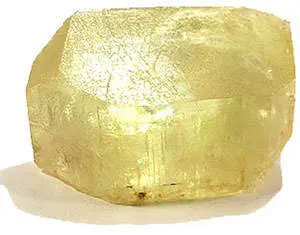 Amblygonite was first discovered and named by August Breithaupt in Saxony, east central Germany, in 1817. Its name derives from the Greek words "amblys," meaning blunt, and "goni," meaning angle. This refers to the four angles of cleavage the mineral possesses. Amblygonite contains about 10% lithium, so it is used as common source of lithium, as well as phosphorus. Amblygonite is used in the production of porcelain enamels and glass dinnerware, as it increases opacity within the glass. Large transparent, sub transparent, and translucent crystals may occur, but as amblygonite is relatively soft, it is cut solely for collectors.
Amblygonite was first discovered and named by August Breithaupt in Saxony, east central Germany, in 1817. Its name derives from the Greek words "amblys," meaning blunt, and "goni," meaning angle. This refers to the four angles of cleavage the mineral possesses. Amblygonite contains about 10% lithium, so it is used as common source of lithium, as well as phosphorus. Amblygonite is used in the production of porcelain enamels and glass dinnerware, as it increases opacity within the glass. Large transparent, sub transparent, and translucent crystals may occur, but as amblygonite is relatively soft, it is cut solely for collectors.
 Amblygonite has been known to be confused with brazilianite, scapolite, albite and
Amblygonite has been known to be confused with brazilianite, scapolite, albite and ![]() quartz. There is a gas flame test, however, which can eliminate this confusion, as it can determine the presence of lithium within the stone, thereby helping to identify it as amblygonite. This test involves lighting powdered amblygonite. If lithium is present, it will yield a bright red flame. Amblygonite is found in a wide range of colors, from white to pale green, beige, pale blue, pink and pale yellow. Straw yellow is the most commonly found color. It is also sometimes found as a colorless stone and in Namibia, a pale mauve variety is also found. Amblygonite has a vitreous to greasy or pearly luster.
quartz. There is a gas flame test, however, which can eliminate this confusion, as it can determine the presence of lithium within the stone, thereby helping to identify it as amblygonite. This test involves lighting powdered amblygonite. If lithium is present, it will yield a bright red flame. Amblygonite is found in a wide range of colors, from white to pale green, beige, pale blue, pink and pale yellow. Straw yellow is the most commonly found color. It is also sometimes found as a colorless stone and in Namibia, a pale mauve variety is also found. Amblygonite has a vitreous to greasy or pearly luster.
 The stone rates a 6 on the hardness scale and is known for its beautiful and strong pleochroism. It occurs as cleavable or compact masses, usually white, in granite pegmatites. It is usually found in association with other phosphates and lithium minerals, such as spodumene, apatite, lepidolite, tourmaline, and albite.
The stone rates a 6 on the hardness scale and is known for its beautiful and strong pleochroism. It occurs as cleavable or compact masses, usually white, in granite pegmatites. It is usually found in association with other phosphates and lithium minerals, such as spodumene, apatite, lepidolite, tourmaline, and albite.
 Amblygonite is mostly found in Penig, Chemnitz, Saxony, in east central Germany. However the best gem quality amblygonite is found in Minas Gerais (particularly around Aracui) in southeast Brazil, as well as in Sakangi, Mogok, Mandalay, in central Burma (Myanmar). Amblygonite is also found in Montebras, Limousin, in central France, and in Bernic Lake, Manitoba, in central Canada. In the United States, amblygonite can be found in Maricopa County, Arizona, Taos country, New Mexico, Riverside County, California, and in the black hills of South Dakota.
Amblygonite is mostly found in Penig, Chemnitz, Saxony, in east central Germany. However the best gem quality amblygonite is found in Minas Gerais (particularly around Aracui) in southeast Brazil, as well as in Sakangi, Mogok, Mandalay, in central Burma (Myanmar). Amblygonite is also found in Montebras, Limousin, in central France, and in Bernic Lake, Manitoba, in central Canada. In the United States, amblygonite can be found in Maricopa County, Arizona, Taos country, New Mexico, Riverside County, California, and in the black hills of South Dakota.